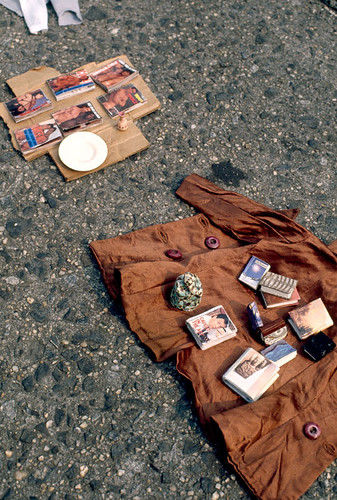

Charles Ledray is a Seattle-born artist I became interested in while working at the Textile Museum last summer. I've been bogged down with school stuff for the past week and haven't posted anything in a while, so here is a little piece I wrote for an assignment about the work pictured above entitled workworkworkworkwork, first exhibited in 1991. FYI: I will be building a "fantasy exhibition" of sorts around this work for a curating class.
*
Charles Ledray
workworkworkworkwork, 1991
588 objects: Fabric, thread, cotton batting, yarn, embroidery floss, nylon cord, carpet, leather, wood, metal, foil, metal chain, wire, nails, porcelain, pumice, beads, buttons, cardboard, corrugated cardboard, paper, magic marker, paint
Approximately 13.7 m x 25.4 cm x 5 cm
Private Collection, Houston, TX
Charles Ledray is an artist working primarily in the area of fibre-base sculpture and installation. His work is characterized by labour-intensive and somewhat obsessive tendencies towards hand making. A compelling blend of high-art and craft, his best-known works are installations comprised of handmade men’s suits, hats, fantastical garments and ceramic vessels that play with multiplicity and scale. In his installation workworkworkworkwork (1991), 588 miniature objects-- among them garments, magazines, housewares and multiple pieces of art-- were displayed in New York’s Astor Place in the form of an impromptu street sale. Each of the objects was painstakingly hand-crafted by Ledray, and their presentation on a busy sidewalk-- often splayed across shrunken replicas of flattened cardboard boxes and rumpled raincoats-- cleverly blurred the lines between art and mass-produced object. The individual objects themselves are an enigmatic combination of abjection and whimsy, like a half-inch dildo in a dollhouse.
Both the presentation and objects of workworkworkworkwork evoke a number of responses in the viewer. The lack of human presence in the installation causes the objects to convey a sense of melancholy and loneliness, imploring one to piece together biographical details of the hypothetical owners of each cluster of tiny belongings for sale. The objects are reminiscent of toys or props-- accessories for a Ken doll whose dream house was foreclosed and who is drifting from fleabag hotel to fleabag hotel. Each object straddles the line between precious and imprecious, with grasshopper-sized hardcover novels standing spine up as if tossed aside among real cigarette butts on the sidewalk. The centrality of labour is evident in the work, from Ledray’s labour to the title of the work to the work of people who labour to make mass-produced objects in sweatshops that move from multi-national chain store to church sale to sidewalk vendor to landfill. Finally, the piece’s presentation on a public sidewalk is dependent on the presence of the pedestrian to complete the work. This brings to mind how members of dominant society-- in the case of workworkworkworkwork, the Manhattan white-collar worker, socialite, window shopper, or tourist-- view people on the margins of society. The homeless, street vendors and people performing menial jobs are relegated as background players against an urban backdrop, always viewed peripherally. The miniaturization of the objects in workworkworkworkwork poignantly reflects this.
While it is easy to get completely caught up in the sense of wonder and delightful seediness of Ledray’s tiny sculptural stand-ins, a key to the work’s success lies in its presentation in public, on a sidewalk in a huge metropolis that dwarfs everything it contains. Situated in Manhattan-- an iconic American city which has long been seen as a centre of commerce, immigration, power and consumption-- workworkworkworkwork interacts with its site’s impressive web of history, from deadly industrial disasters in garment factories and riots fuelled by class resentment to the economic and social conditions of New York City in 1991 when workworkworkworkwork was first exhibited. The relationship between the objects-- which despite their scale evoke personal histories that feel very real-- and the site activate something much larger than the diminutive objects laboured over by Ledray: a greater social history of a city that lies deeper than a sidelong glance during a brisk walk across a crowded intersection.
Photos courtesy of the Whitney's website: http://whitney.org/Exhibitions/CharlesLeDray/Images
No comments:
Post a Comment